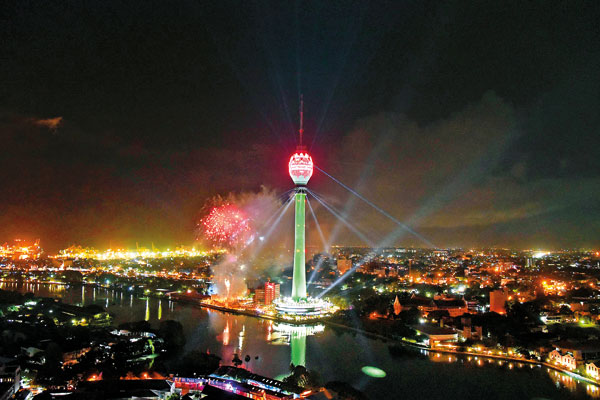Sunday Times 2
Why is Sri Lanka resource-rich yet wealth-poor?
View(s):By Panduka Keerthinanda
Sri Lanka is a nation of paradox: it is endowed with abundant natural resources, including fertile agricultural land and valuable minerals, yet it struggles with widespread poverty and economic instability. This discrepancy arises from a complex interplay of historical policies, governance issues, economic structure, and external factors.
Given here are the reasons behind this paradox, supported by evidence from the search results.

Historical and policy-related constraints
Outdated agricultural policies: The Paddy Lands Act of 1958, still in force, was intended to protect tenants but has instead led to generational land disputes and entrenched poverty among farmers. This policy discourages investment and innovation in agriculture, perpetuating inefficiency and low productivity.
Mismanagement of mineral resources: Sri Lanka possesses high-quality graphite, phosphate, and ilmenite deposits. But these resources are under-exploited due to corruption, mismanagement, and lack of technological expertise. For example, the nationalization of graphite mines in 1971 led to a decline in exports from dominance to just 10,000 metric tons annually, despite reserves of 1.5 mn tonnes. Similarly, phosphate mining suffers from quality issues, leading to returned products and lost revenue .
Lack of political will: Short-term political agendas prioritize votes over long-term economic growth. Policies are often skewed to serve immediate interests rather than sustainable development, resulting in wasted resources and missed opportunities.
Structural economic issues
Over-reliance on low-value agriculture: Agriculture employs about 30% of the workforce but contributes only 7–8% to GDP. Most farmers work in low-productivity subsistence farming, with limited access to modern technology, credit, and markets. This traps rural populations in poverty, as agricultural growth has not translated into higher incomes .
Inequality between urban and rural areas: Wealth is concentrated in urban centres, while rural areas (home to 75% of the population and 85% of the poor) lack infrastructure, education, and opportunities. This spatial inequality hinders inclusive growth .
Vulnerability to external shocks: Sri Lanka’s economy depends on exports of tea, rubber, and apparel, which are susceptible to global price fluctuations and demand shifts. The COVID-19 pandemic, for instance, caused a 25% decline in exports, exacerbating poverty and unemployment .
Governance and
institutional failures
Inefficient State-Owned Enterprises (SOEs): SOEs, such as those in mining and energy, are often managed by political appointees rather than professionals. They operate without accountability, incurring massive losses. For example, the national airline lost more money in eight months than the annual budget for poverty alleviation programmes.
Protectionism and lack of competition: Government monopolies in sectors like lotteries and aviation stifle competition and innovation. Profits in these sectors arise from monopolistic practices rather than wealth creation, further hindering economic dynamism .
Erosion of wealth creation capacity:As Bill Gates noted, wealth is not merely having resources but the ability to create and recreate wealth. Sri Lanka has failed to develop this capacity due to poor governance, corruption, and a lack of entrepreneurial culture.
Social and developmental challenges
High malnutrition and poor human capital: 22% of Sri Lankans suffer from malnutrition, which affects cognitive development and productivity. Despite high primary school enrolment, education quality is low, limiting the workforce’s skills and adaptability .
Inadequate social safety nets: While poverty rates have decreased, social protections remain weak. Only a small fraction of the poor benefit from programs like cash transfers, leaving many vulnerable to shocks like health crises or natural disasters.
Impact of climate change: Frequent floods and droughts threaten food security and livelihoods, particularly in rural areas. This exacerbates poverty and strains limited resources .
Global and
geopolitical factors
Competition and market access: Sri Lanka faces intense competition from countries like Madagascar (in graphite) and Vietnam (in agriculture). Without competitive advantages or value addition, it struggles to retain market share.
Dependence on foreign investment and aid: While foreign investment is needed for infrastructure and mining, Sri Lanka has often partnered with unqualified companies, leading to sub-optimal outcomes. Additionally, the country relies on loans and aid to sustain basic imports, such as fuel, further eroding economic sovereignty .
Potential solutions and missed opportunities
Value addition in resources: Sri Lanka could process minerals like graphite and phosphate domestically to capture higher value. For example, graphite could be used in batteries and electronics, while phosphate could be refined into fertilizers .
Tourism and services expansion: Tourism, which earned $15 billion in 2024, could be expanded to $100–150 billion by leveraging natural scenery and cultural assets. Similarly, IT and BPO services could grow significantly with targeted investments .
Port and logistics development: Strategically located ports like Colombo and Hambantota could become regional hubs, boosting trade and logistics services .
Agricultural modernization: Investing in high-value crops (e.g., organic tea, spices) and agro-processing could increase farmers’ incomes and export earnings.
The path forward
Sri Lanka’s poverty amidst plenty is not inevitable. It stems from deep-rooted institutional and policy failures rather than a lack of resources. To transform its economy, Sri Lanka must:
1. Reform policies to encourage private investment and competition.
2. Invest in human capital through better education and healthcare.
3. Modernize agriculture and mining to add value and increase productivity.
4. Strengthen governance to curb corruption and improve public sector efficiency.
5. Leverage its geographic location to become a tourism, logistics, and services hub.
With political will and strategic action, Sri Lanka could potentially triple its GDP in a decade, lifting millions out of poverty. As the World Bank emphasizes, growth must be inclusive and coupled with investments in people and resilience to ensure sustainable prosperity .
(The writer is an attorney-at-law)

